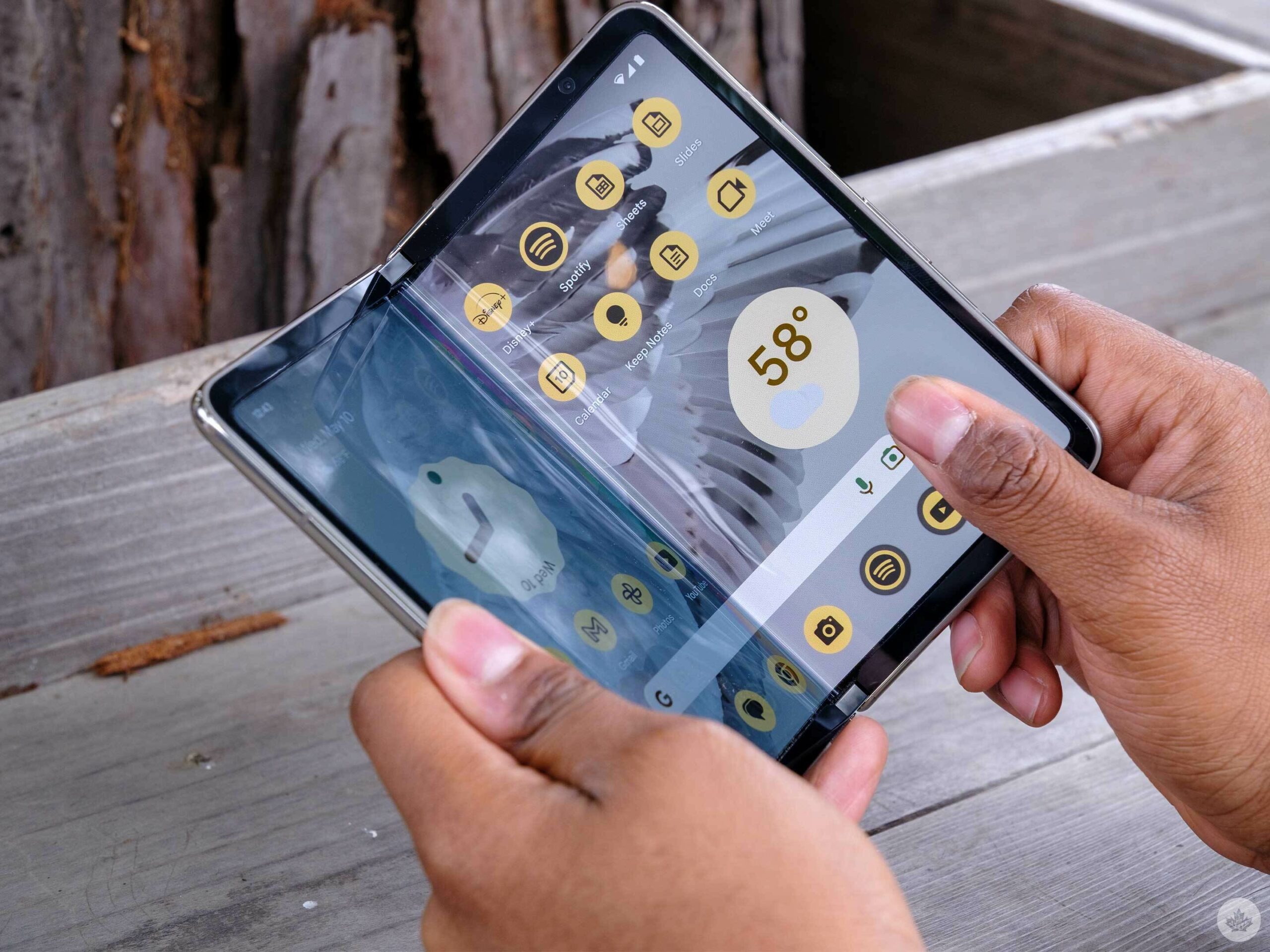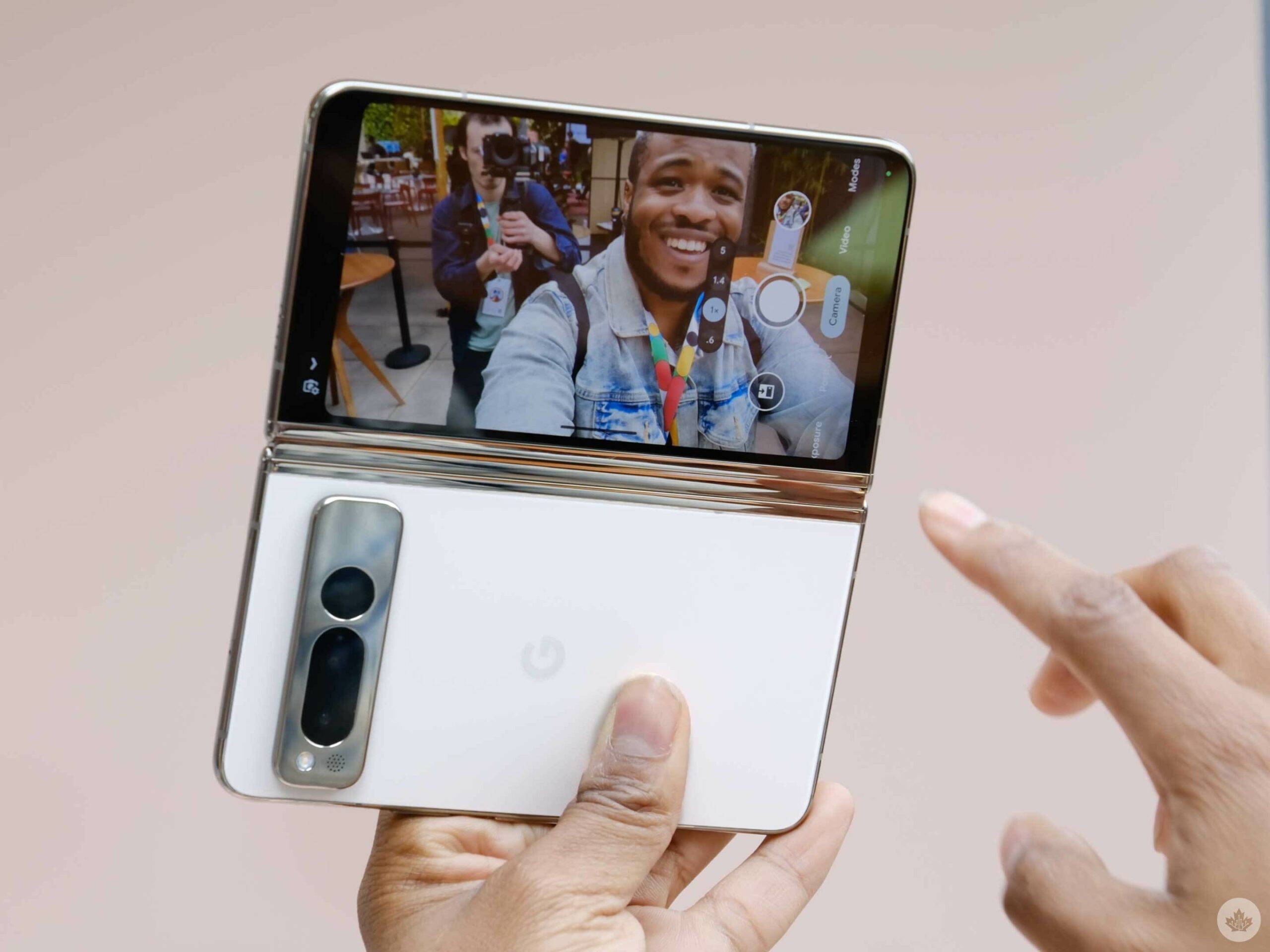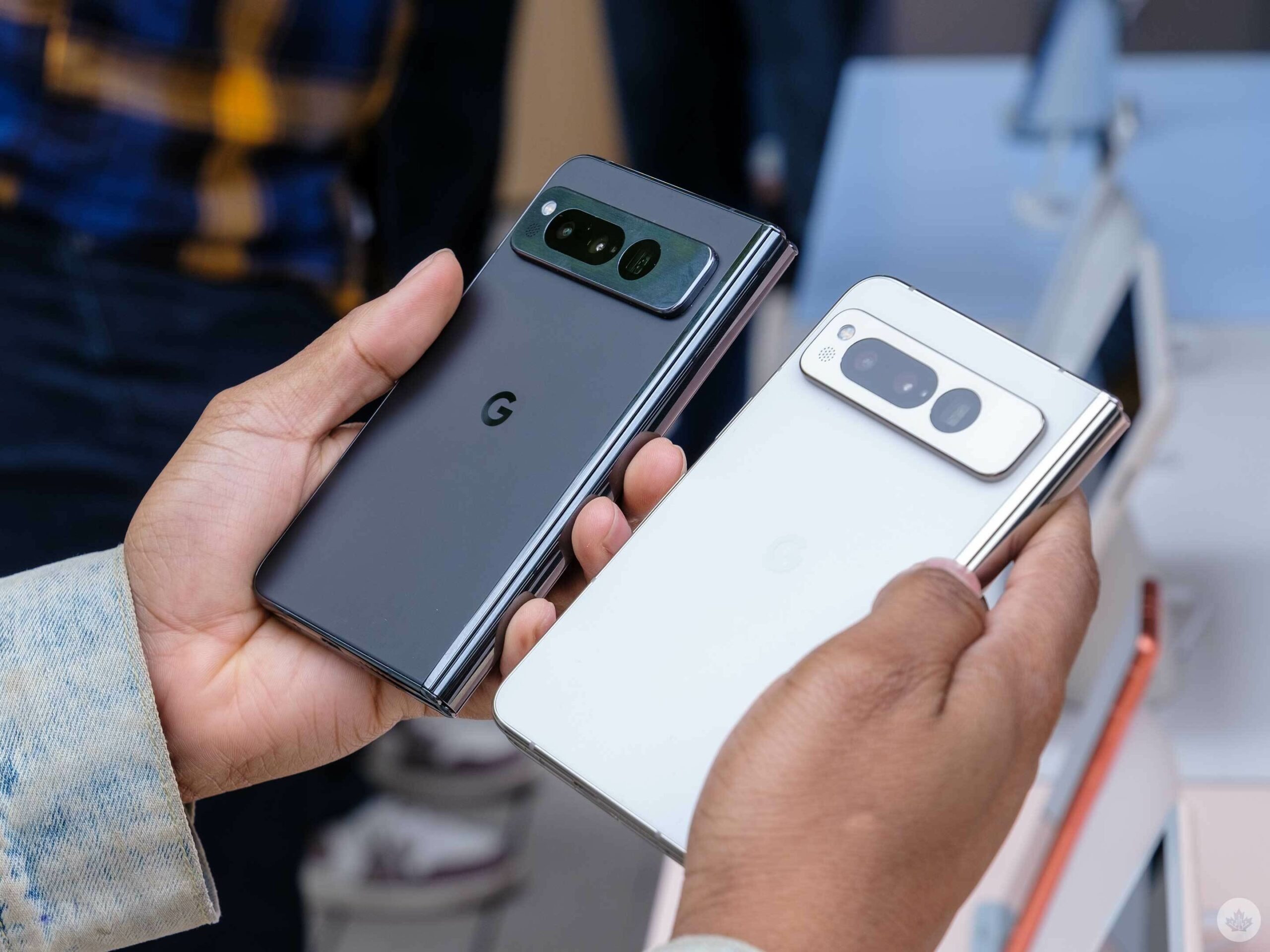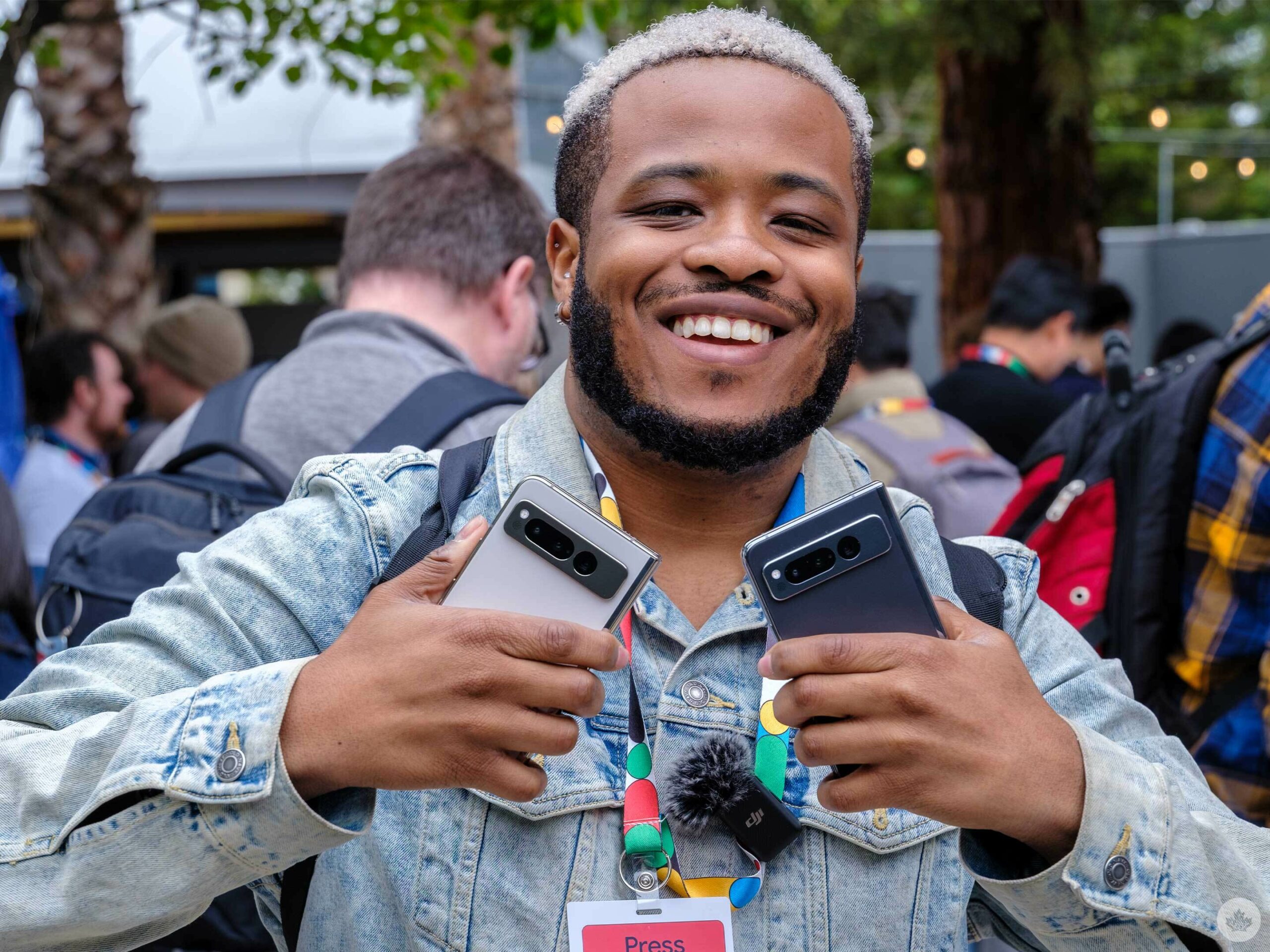At I/O 2023, I had the opportunity to go hands-on with the Pixel Fold, Google’s first shot at a foldable. What’s most noteworthy about this hands-on is it’s more of a look toward the future instead of something Canadians should really care about (yet), as the handset isn’t launching in the North.
That said, I still decided to try out the Pixel Fold because I’m incredibly excited about the future of foldables, I think the form factor is really attractive, and it’s not the first time that Google skipped Canada with the first iteration of a product (i.e., Google Home Hub), but made later versions available. I’m hoping it’s the same situation with the Pixel Fold.
Now that I’ve said why I tried out Google’s new foldable, here are my initial thoughts: It’s awesome.
Google has created a premium-feeling folding device that I found difficult to put down. However, the phone isn’t faultless.
Folded: 5.8-inch FHD+ (1080 x 2092) OLED display, 120Hz refresh rate | Unfolded: 7.6-inch FHD+ (2208 x 1840) OLED display, 120Hz refresh 1
Main Screen: 7.6 inches 120Hz AMOLED 2x, Infinity Flex Display (2176 x 1812) | Cover Screen: 6.2 inches 120Hz Dynamic AMOLED 2X Display (2316 x 904)
256GB, 512GB and 1TB of storage
Folded: 5.5 height x 3.1 width x 0.5 depth (inches) | Unfolded: 5.5 height x 6.2 width x 0.2 depth (inches)
Folded: 67.1 x 155.1 x 15.8mm(Hinge) ~ 14.2mm(Sagging) | Unfolded: 130.1 x 155.1 x 6.3mm
48-megapixel (OIS, wide angle) + 10.8-megapixel (telephoto 5x optical ) + 10.8-megapixel (ultra-wide angle)
50MP Wide-angle Camera F1.8, 12MP Ultra Wide Camera F2.2, 10MP Telephoto Camera F2.4 | Cover camera: 10MP Selfie Camera F2.2
9.5-megapixel + 8-megapixel
10 MP Cover Camera F/2.2 | 4MP Under Display Camera F1.8
Face ID, Three axis gyro, Accelerometer, Ambient light sensor, Barometer
Capacitive Fingerprint sensor (side), Accelerometer, Barometer, Gyro sensor, Geomagnetic sensor, Hall sensor, Proximity sensor, Light sensor
Colours: Obsidian, Porcelain
Graygreen, Phantom Black, Beige [Samsung.com Exclusive] Burgundy
Folded: 5.8-inch FHD+ (1080 x 2092) OLED display, 120Hz refresh rate | Unfolded: 7.6-inch FHD+ (2208 x 1840) OLED display, 120Hz refresh 1
Main Screen: 7.6 inches 120Hz AMOLED 2x, Infinity Flex Display (2176 x 1812) | Cover Screen: 6.2 inches 120Hz Dynamic AMOLED 2X Display (2316 x 904)
256GB, 512GB and 1TB of storage
Folded: 5.5 height x 3.1 width x 0.5 depth (inches) | Unfolded: 5.5 height x 6.2 width x 0.2 depth (inches)
Folded: 67.1 x 155.1 x 15.8mm(Hinge) ~ 14.2mm(Sagging) | Unfolded: 130.1 x 155.1 x 6.3mm
48-megapixel (OIS, wide angle) + 10.8-megapixel (telephoto 5x optical ) + 10.8-megapixel (ultra-wide angle)
50MP Wide-angle Camera F1.8, 12MP Ultra Wide Camera F2.2, 10MP Telephoto Camera F2.4 | Cover camera: 10MP Selfie Camera F2.2
9.5-megapixel + 8-megapixel
10 MP Cover Camera F/2.2 | 4MP Under Display Camera F1.8
Face ID, Three axis gyro, Accelerometer, Ambient light sensor, Barometer
Capacitive Fingerprint sensor (side), Accelerometer, Barometer, Gyro sensor, Geomagnetic sensor, Hall sensor, Proximity sensor, Light sensor
Colours: Obsidian, Porcelain
Graygreen, Phantom Black, Beige [Samsung.com Exclusive] Burgundy
Possibly the best form factor
Firstly, I love that aspect ratio. The Pixel Fold’s front panel sports a 5.8-inch panel with a 17.4:9 aspect ratio, making the display considerably wide. The Galaxy Z Fold 4′s aspect ratio is 23.1:9, which is quite tall, so the Pixel Fold’s ratio is more user-friendly in comparison. It feels more comfortable and similar to a typical 16:9 ratio.
I’ve never had an issue with the ratio on the Galaxy Fold 4’s front display; sure, it’s tall, but it’s still entirely usable. However, now that I’ve spent time with the Pixel Fold, I think this might be the best form factor for phone-to-tablet foldables.
Flipping the device over to the back, the handset offers a porcelain-like feeling rear that’s incredibly premium. It feels similar to the Pixel Tablet’s backing, but there’s a slight step up. You won’t get smudges or fingerprints on the back of this foldable.
The handset comes in ‘Obsidian’ and ‘Porcelain’ colours, with Porcelain being the clear winner of the two options.
Unfolded experience
When unfolded, the display feels great and glass-like. It’s a clear improvement from Samsung’s first Galaxy Fold (or even the Galaxy Fold 2), but the crease seems even more noticeable than the South Korean phone maker’s most recent foldables. Of course, I was outside, and it was a pretty bright and overcast day. We also didn’t have a Fold 4 to directly compare against. However, we did have Oppo’s Find N on hand, and the Pixel Fold’s crease was definitely more noticeable (the Oppo Find N isn’t officially available in Canada).

While the Pixel Fold can go completely flat, it doesn’t fold out easily. I’m not sure if this would bother me if I were using the handset every day. However, it’s definitely worth noting. To go even further, the foldable doesn’t lay completely flat either. Looking into this, it seems the camera bump prevents the foldable from doing so.
I played YouTube and Disney+ on the Pixel Fold’s tabletop mode, which means folded at a 90-degree angle so that the Pixel Fold serves as its own phone stand, and the fact that it wasn’t completely flat wasn’t an issue.
![]()
Similar to the Galaxy Fold 2, there looks to be a screen protector on the display. I tried to pull it off to see what would happen, but it’s really attached to the panel. This is good as we don’t want the Pixel Fold to suffer a similar issue to Galaxy Fold’s screen breaking; however, it also makes the phone’s display look slightly cheaper than the Galaxy Fold 4 or Oppo Find N.
What’s important to note about the Pixel Fold when it’s either folded or unfolded is how thin the device is. If you look at the numbers, the Pixel Fold is only a bit thinner than the Fold 4 (unfolded: 6.4mm vs 5.8mm and folded: 14.2mm vs 12.8mm), but these millimetres really count as the Pixel Fold feels noticeably thinner than the competition. This thinness really helps the smartphone feel more premium.
“MobileSyrup’s Brad Bennett had to pull me out of the hands-on area because I didn’t want to part ways with the Pixel Fold; I was enjoying it that much.”
Speaking of folding and unfolding, the hinge seems pretty solid. However, in comparison to the Oppo Find N, the Pixel Fold feels a bit stiffer when you unfold it. The Find N also has a nice click when you unfold it. That’s not to say the Pixel Fold experience is bad, but it feels like something Google can improve in the future. However, that likely has to do with Google’s claim that the Fold has the most durable hinge on the market.
Nitty Gritty
The Pixel Fold features Google’s Tensor G2, 12GB of RAM, and up to 512GB of storage, depending on the variant. We didn’t get the chance to really put the hardware through its paces, but these are similar specs to what’s available in the Pixel 7 Pro, so the foldable should run smoothly.
The Pixel Fold also sports two 120Hz displays that feel smooth when scrolling through apps, the settings menu and more. However, I didn’t play any games on the handset and also didn’t focus on the 120Hz scrolling that much.

The foldable features five cameras, starting with a 48-megapixel primary shooter, a 10.8-megapixel ultrawide, a 10.8-megapixel telephoto with 5x zoom, a 9.5-megapixel selfie camera on the front and an 8-megapixel on the inside. I tested the 48-megapixel, and it seems decent, even to take selfies with, but I need to spend a lot more time with the cameras before I can make any concrete statements.
However, my main issue with the cameras during my hands-on time with the device wasn’t the quality of the photos but the placement of the inner camera. On the Pixel Fold, the inner camera is on the top bezel on the right-hand side. Compared to devices like the Z Fold 4, which uses an under-display camera, and the Oppo Find N, which features a hole punch shooter, it seems strange that Google would place the camera on the bezel. It makes the handset seem a bit less premium.

In fact, I’d rather Google not have a camera at all than have it on the bezel. Of course, I might be in the minority for this as the Pixel maker likely placed the camera on the inside for video calling, but still, I think it’s a weird misstep on Google’s part.
The handset also features a 4,821mAh battery that I didn’t get the chance to really test.
The Pixel Fold seems awesome
At the end of the day, the Pixel Fold isn’t coming to Canada, but there’s also a lot to look forward to. I mentioned the Oppo Find N in this hands-on because a friend of mine (Miriam Joire of Mobile Tech Podcast) brought me the handset to play with during the hands-on session, but this phone isn’t available to Canadians either (and likely never will be). However, in Canada, we have the rest of the Pixel line, and while we don’t always get each product, there’s a strong chance that we’ll see the next Pixel Fold (if there is one). With this in mind, I really think Google might have something here that can compete against Samsung’s Fold series.

Of course, I’d need to really put it through its paces to say whether this device is worse than, similar to, or better than the Fold 4 or the Fold 5 that will surely launch later this year. But the premium slim build and, more importantly, the form factor makes it different from Samsung’s offering, and during my 40-ish minutes with the handset, I really enjoyed my time with it.
At the beginning of this hands-on, I said that “Google has made a premium-feeling device, one that was hard for me to put down” — and more than any phone in recent years, it really was difficult to put down. MobileSyrup’s Brad Bennett literally had to pull me out of the hands-on area because I didn’t want to part ways with the Pixel Fold; I was enjoying it that much.
The Pixel Fold in the U.S. costs $1,799 USD (roughly $2,404 CAD), which is the equivalent of the price of the Galaxy Fold 4 in the United States.
Photography by Bradley Bennett.
